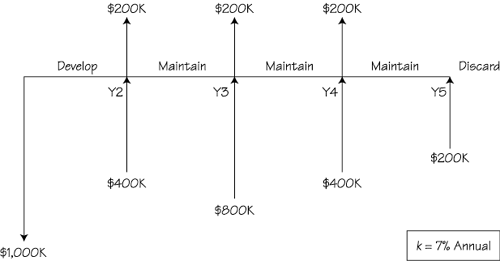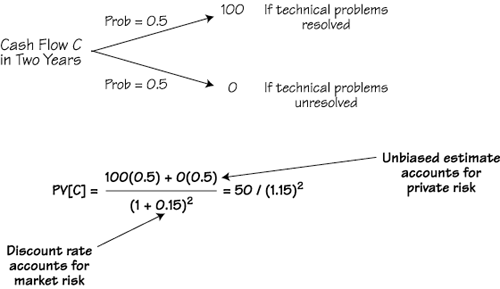Valuation Basics: How to Quantify the Value of Capital Investments
| Valuation is the process of estimating how much an asset is worth. An XP project is subject to the same fundamental principles of valuation as any other real asset, as summarized this way:
That single paragraph contains references to most of the fundamental principles of valuation (shown in boldface, added for emphasis), so let's pick it apart now. Comprehensive coverage of the subject is beyond the scope of this chapter. In what follows, we provide an overview of only the most basic concepts as they relate to the current discussion. Suggestions for further reading are provided at the end of the chapter. In finance, the costs and benefits associated with an investment are called cash flows. Investments are compared only on the basis of their cash flows. Cash flows are often represented in tabular form according to chosen time periods for example, in years, quarters, or months. Usually, there is an original investment, C0, represented as a negative number. Subsequent cash flows are denoted as C1, … Cn, spanning the time horizon in which the investment incurs costs and generates benefits. Discounted Cash Flow and Net Present ValueThe present value (PV) of a future cash flow is the value of the cash flow as though it were received today. How does one calculate the PV of a future cash flow? Moving forward from present to future, an investment is expected to grow at a certain rate of return. Now turn it around: Moving backward from future to present, an investment shrinks with the same rate of return. When moving back in time, the rate of backward adjustment is called the discount rate. The process of backward adjustment itself is called discounting. The general technique of valuing a capital investment project by summing its discounted future cash flows is known as discounted cash flow (DCF). The DCF calculation doesn't usually include the initial investment, C0. When that initial investment is included (represented as a negative cash flow), the net present value (NPV) is obtained: the benefits minus the costs. All of this is expressed in the following simple formula:
Here, the C's represent the cash flows, the subscripts represent the periods in which the cash flows occur, and k is the per-period discount rate. The NPV formula tells us whether the investment is worth more than it costs. The rule is that if NPV is positive, the investment is worth undertaking it generates more value than it costs. If it is negative, it should be forgone it generates less value than it costs. If it is zero, we are indifferent between undertaking and forgoing it. A Valuation ExampleWe illustrate DCF and NPV in action by considering the development scenario illustrated in Figure 43.1. The horizontal line represents the time horizon extending to five years out. The outgoing arrows represent negative cash flows, or expected costs, including the initial investment (development cost) and the subsequent investments (maintenance costs). The incoming arrows represent positive cash flows, or expected benefits from sales revenues. The discount rate is given as 7% annual. Figure 43.1. Cash flows of a software development project
The straight net value of the investment is calculated simply by summing all the cash flows. In thousands of dollars, the calculation is as follows:
According to this result, the net value is positive, and the project should be undertaken. However, the DCF approach yields a very different conclusion. The NPV, calculated using DCF, is as follows:
The negative result tells us that the project is not worth undertaking. The cost of the investments exceeds the return on investment expected from the project. Therefore, if undertaken, the project would destroy value rather than create it. It's All about RiskRisk management is taken very seriously in XP. Clearly, then, risk has to be taken into consideration in any economic valuation of an XP project. Software engineers have an intuitive view of risk that is related more to project management, even to sociology or psychology, than to finance. XP is no exception. Usually, risk is characterized by what can go wrong in the project, and the strategies for dealing with this problem have been limited to implementing the riskiest artifacts first. From the financial point of view, however, risk has a much more precise, well-defined meaning. Financial risk refers to the variability in the returns of an asset [Ross+1996]. It has two components:
Private risk corresponds to the traditional software engineering view of risk. However, no business works in a vacuum all businesses participate in a market and are affected by systematic risks that permeate the system in general and the sector in which they operate in particular. These systematic risks range from the overnight bank loan rate determined by the Federal Reserve Bank (in the United States) to the outbreak of war.
Table 43.1 contrasts the well-known risks identified for an individual XP project with the market risks that affect many projects. Market risks are often easier to tackle because they are priced by financial markets. Those are the risks that well-diversified investors are mainly worried about because diversification can minimize, if not completely eliminate, private risk. Both market and private risk can figure into the simple NPV equation. When cash flows are estimated, effectively private risk must be taken into account. If things go well for the project, more will be earned. If things go badly, the cash flows will be smaller. So the private risk is accounted for in the unbiased estimates of cash flows in the numerator of a DCF term in the NPV equation. An unbiased estimate of a cash flow is calculated as a statistical expectation by considering as many scenarios as is feasible and the respective likelihood of these scenarios. In contrast, market risk is accounted for in the denominator of a DCF term by adjusting the discount rate. The higher the market risk, the higher the discount rate. Figure 43.2 illustrates how the NPV equation accounts for private and market risk. Figure 43.2. Accounting for private and market risk in the NPV equation
Corporations have developed practices to determine discount rates based on the returns of past projects and grouping of like projects into risk categories. In addition, many organizations specialize in the estimation of market risk, examining the historical returns of companies and deducing the amount of market risk borne to develop projections. |
EAN: 2147483647
Pages: 445



